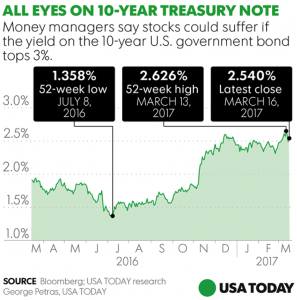On Wednesday, 15 March 2017, the Federal Reserve Bank wrapped up a 2-day meeting and raised the interest rate by 25-basis points to 1%. This means that the federal funds rate (FFR) is now higher, and it affects everything from the cost of borrowed capital, the interest paid on savings, and the strength of the USD. The FOMC decision came in line with market expectations, on the back of strengthening economic activity in the US, and a tightening of the labor market.
The US economy is expected to grow at a rate of 2.1% in 2017 and 2.1% in 2018. Further, Fed chair Janet Yellen alluded to the strengthening of the US economy and the need for gradual interest rate hikes over the course of the year. Recall that at the beginning of 2017, the Fed had been calling for 3 rate hikes. This is the first of the three, and if expectations are in line with economic realities, we could see an interest rate of 1.50% – 1.75% by the year’s end.
How Will Rising Interest Rates Affect US Consumers and Debt Levels?
 A week ago, an article was written by Jessica Dickler vis-à-vis credit card debt. In the article, she alluded to the 157 million Americans who are currently in debt with their credit cards. The 25-basis point increase in the federal funds rate (FFR) will cost an additional $1.6 billion in additional finance charges this year. Bankrate.com chief analyst, Greg McBride, cautioned about the effect of rising interest rates on variable-rate loans. These include adjustable-rate mortgages, credit cards and home equity lines of credit.
A week ago, an article was written by Jessica Dickler vis-à-vis credit card debt. In the article, she alluded to the 157 million Americans who are currently in debt with their credit cards. The 25-basis point increase in the federal funds rate (FFR) will cost an additional $1.6 billion in additional finance charges this year. Bankrate.com chief analyst, Greg McBride, cautioned about the effect of rising interest rates on variable-rate loans. These include adjustable-rate mortgages, credit cards and home equity lines of credit.
The 30-year fixed rate for mortgages is approximately 4.38%. In December 2012, that figure was 3.50% – a record low. With multiple rate hikes on the horizon, we are moving further away from the record low. To counter these growing debt concerns, personal bankers and financial analysts are advising clients to lock in fixed-interest rate mortgages and long-term loans. Adjustable rates for credit are only going to hurt the borrower in the long-term. Fixed-rate options are preferred, especially in a climate of increasing interest rates.
How to Deal with Rising Debt?
There is a glut of literature on how to effectively deal with personal debt problems. Of course, meticulous record keeping is necessary when debtors and creditors are involved. People who have become unemployed may need to enlist the support of debt management consultants to negotiate on their behalf. It is difficult to reduce fixed expenditures when income levels abruptly cease, but the necessary bills must be paid, or plans must be made to pay towards them.
Creditors will invariably work with people who approach them on debt repayment terms. One of the ways to manage multiple lines of credit is with debt consolidation. This consolidates all debt into a single loan which must be repaid at a lower interest rate. The priority with all forms of debt are the secured loans. These include vehicles, homes, and other fixed assets. Unsecured loans such as credit cards and student loans are a step lower on the list of priorities.



